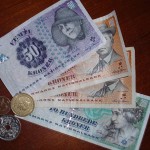Yesterday’s trade saw USD/JPY within the range of 122.93-123.73. The pair closed at 123.34, down 0.22% on a daily basis. The daily high has also been the highest level since July 2nd, when the cross registered a high of 123.75.
At 8:44 GMT today USD/JPY was up 0.17% for the day to trade at 123.61. The pair touched a daily high at 123.65 at 8:32 GMT.
A number of macroeconomic reports are to be watched today, as follows:
Fundamentals
United States
Producer prices
United States’ annualized producer price inflation probably rose to a level of -0.9% in June, according to the median estimate by experts, from -1.1% in May. If so, this would be the fifth consecutive month of decline in the annual Producer Price Index. This index reflects the change in prices of over 8 000 products, sold by manufacturers during the respective period. The Producer Price Index (PPI) differs from the Consumer Price Index (CPI), which measures the change in prices from consumer’s perspective, due to subsidies, taxes and distribution costs of different types of manufacturers in the country. The simple logic behind this indicator is that if producers are forced to pay more for goods and services, they are more likely to pass these higher costs to the end consumer. Therefore, the PPI is considered as a leading indicator of consumer inflation. In case, however, annual producer prices fell at a lesser rate, this would usually have a bullish effect on the greenback.
The nation’s annualized core producer price inflation, which excludes prices of volatile categories such as food and energy, probably advanced to 0.7% in June from 0.6% in the prior month. The latter has been the lowest annual rate of increase in the PPI in at least 8 years. This indicator is quite sensitive to changes in aggregate demand, thus, it can be used as a leading indicator for economy. However, because of its restrained scope, it is not suitable for future inflation forecasts. The Bureau of Labor Statistics is expected to report on the official PPI performance at 12:30 GMT.
Industrial output, Capacity Utilization
Industrial output in the United States probably expanded 0.2% in June compared to May, following three consecutive months of contraction. In May total output shrank 0.2% due to lower manufacturing and mining production. Manufacturing output fell at a monthly rate of 0.2% in May, the index for mining output tumbled 0.3%, while, at the same time, the output of utilities rose 0.2% during the month.
The index of industrial production reflects the change in overall inflation-adjusted value of output in the three major sectors mentioned above. The index is sensitive to consumer demand and interest rates. As such, industrial production is an important tool for future GDP and economic performance forecasts. Those figures are also used to measure inflation by central banks as very high levels of industrial production may lead to uncontrolled levels of consumption and rapid inflation. It is a coincident indicator, which means that changes in its levels generally echo similar shifts in overall economic activity. A larger-than-projected increase in the index would usually boost demand for the US dollar.
The Board of Governors of the Federal Reserve is to release the production data at 13:15 GMT.
In addition, Capacity Utilization rate in the country probably remained steady at 78.1% in June. It has been the lowest utilization rate since August 2013, when a rate of 77.9% was reported. This indicator represents the optimal rate for a stable production process, or the highest possible level of production in an enterprise, in case it operates within a realistic work schedule and has sufficient raw materials and inventories at its disposal. High rates of capacity utilization usually lead to inflationary pressure. In general, higher-than-anticipated rates tend to be dollar positive.
The ”Beige Book” report
At 18:00 GMT the Federal Reserve is to release its ”Beige Book” report. It is published eight times during the year. Each of the banks in the 12 Federal Reserve Districts gathers data in regard to current economic situation in the country on the basis of interviews with key business contacts, economists, market experts, and other sources. In case the Beige Book presents an optimistic economic outlook, this will usually support the US dollar, while a pessimistic view will usually have a bearish effect on the currency.
Correlation with other Majors
Taking into account the week ended on July 12th and the daily closing levels of the major currency pairs, we come to the following conclusions in regard to the strength of relationship:
USD/JPY to GBP/USD (0.8516, or very strong)
USD/JPY to AUD/USD (0.4909, or moderate)
USD/JPY to EUR/USD (0.1180, or weak)
USD/JPY to NZD/USD (-0.5850, or strong)
USD/JPY to USD/CHF (-0.5857, or strong)
USD/JPY to USD/CAD (-0.7086, or strong)
1. During the examined period USD/JPY moved almost equally in one and the same direction with GBP/USD.
2. USD/JPY moved strongly in the opposite direction compared to USD/CAD, USD/CHF and NZD/USD during the past week.
3. The correlation between USD/JPY and EUR/USD was insignificant during the past week.
Bond Yield Spread
The yield on Japanese 2-year government bonds went as high as 0.015% on July 14th, after which it slid to 0.013% at the close to gain 0.003 percentage point on a daily basis.
The yield on US 2-year government bonds climbed as high as 0.681% on July 14th, after which it fell to 0.637% at the close to lose 4 basis points (0.040 percentage point) for the day.
The spread between 2-year US and 2-year Japanese bond yields, which reflects the flow of funds in a short term, shrank to 0.624% on July 14th from 0.671% during the prior day. The July 14th spread has been the lowest one since July 9th, when the difference was 0.608%.
Meanwhile, the yield on Japan’s 10-year government bonds soared as high as 0.477% on July 14th, or the highest level since July 7th (0.484%), after which it slid to 0.452% at the close to appreciate 1.6 basis points (0.016 percentage point) compared to July 13th.
The yield on US 10-year government bonds climbed as high as 2.450% on July 14th, after which it slipped to 2.388% at the close to lose 5.8 basis points (0.058 percentage point) on a daily basis.
The spread between 10-year US and 10-year Japanese bond yields narrowed to 1.936% on July 14th from 2.012% during the prior day. The July 14th yield difference has been the lowest one since July 9th, when the spread was 1.935%.
Pivot Points
According to Binary Tribune’s daily analysis, the central pivot point for the pair is at 123.33. In case USD/JPY manages to breach the first resistance level at 123.74, it will probably continue up to test 124.13. In case the second key resistance is broken, the pair will probably attempt to advance to 124.54.
If USD/JPY manages to breach the first key support at 122.94, it will probably continue to slide and test 122.53. With this second key support broken, the movement to the downside will probably continue to 122.14.
The mid-Pivot levels for today are as follows: M1 – 122.34, M2 – 122.74, M3 – 123.14, M4 – 123.54, M5 – 123.94, M6 – 124.34.
In weekly terms, the central pivot point is at 122.02. The three key resistance levels are as follows: R1 – 123.67, R2 – 124.58, R3 – 126.23. The three key support levels are: S1 – 121.11, S2 – 119.46, S3 – 118.55.





